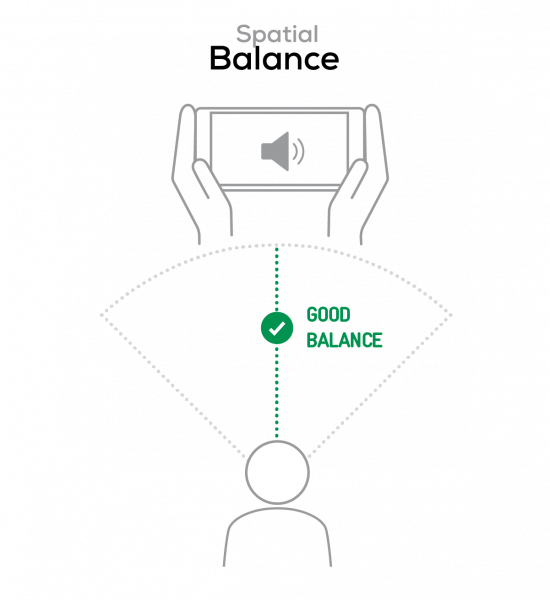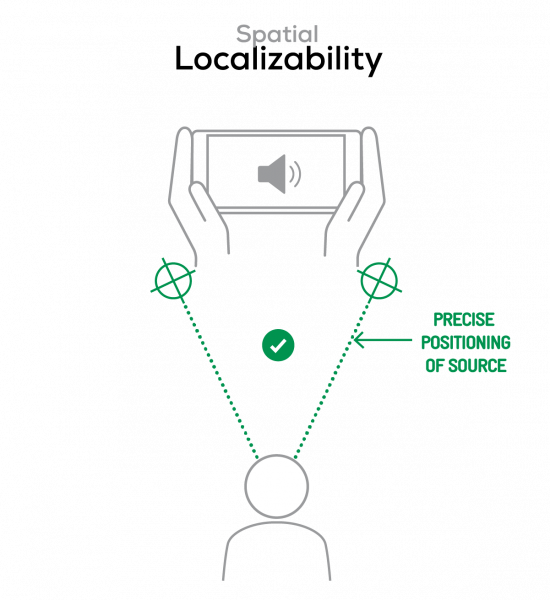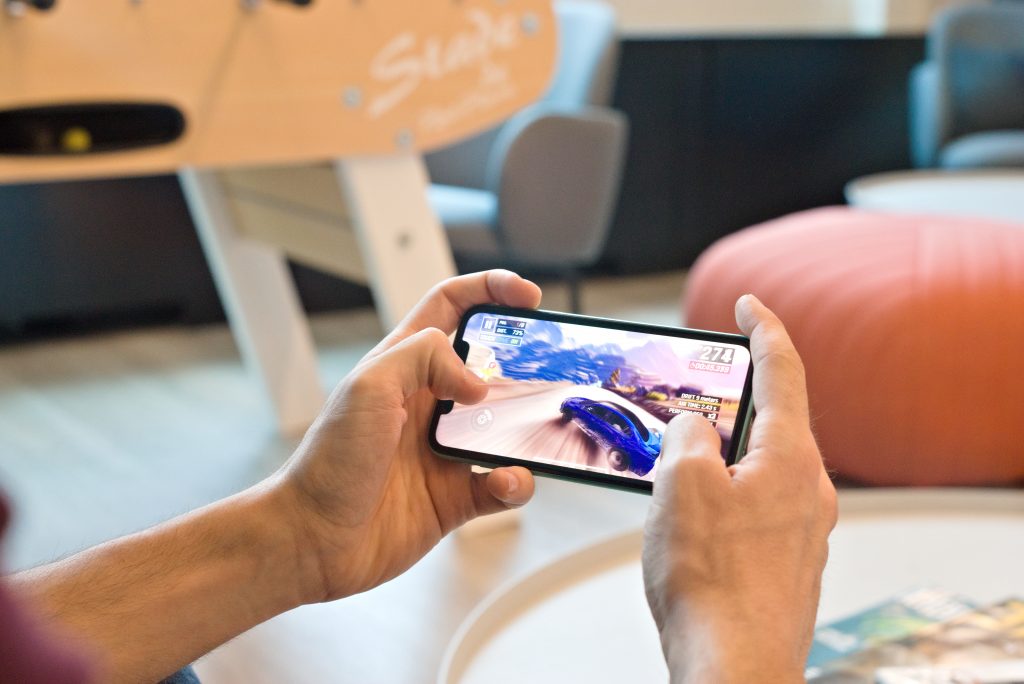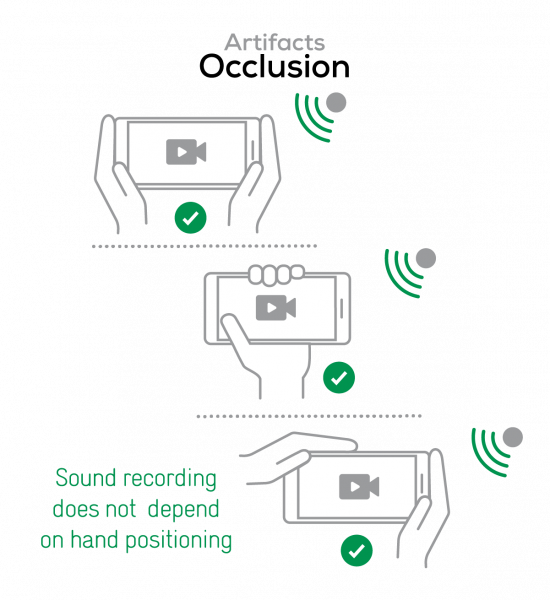Apple introduced its iPhone 11 last fall, and while the focus is usually on the latest phones’ camera setups, the audio capabilities of these devices are often glossed over. But there is much to be said about the audio qualities of the iPhone 11 family.
While the camera setups between the iPhone 11 and 11 Pro Max models differ, on the audio side, Apple packed the identical solid specs into all versions of its iPhone 11 models. It added what it called spatial audio, which is supposed to simulate theater-like surround sound for a more immersive experience. The iPhone 11 also employs Dolby Atmos technology so that sound moves “around you in 3D space — you feel like you’re inside the action,” according to Apple’s website.
We already tested the iPhone 11’s main and front cameras, and now we round out our series of reviews on this device with our audio review. We put the iPhone 11 through our rigorous DXOMARK Audio test suite to measure its performance both at recording sound using its built-in microphones and at playing audio back through its built-in speakers. In this review, we will break down how it fared in a variety of tests and several common use cases. And we’ll see whether the audio quality differs from its larger sibling, the iPhone 11 Pro Max.
Audio specifications include:
- Stereo speakers
- Multiple microphones, including active noise cancellation
- User-configurable volume limit
- Spatial audio playback
About DXOMARK Audio tests: For scoring and analysis in our smartphone audio reviews, DXOMARK engineers perform a variety of objective tests and undertake more than 20 hours of perceptual evaluation under controlled lab conditions. This article highlights the most important results of our testing. Note that we evaluate both Playback and Recording using only the device’s built-in hardware and default apps. (For more details about our Playback protocol, click here; for more details about our Recording protocol, click here.)
Test summary


The iPhone 11 achieved an overall audio score of 71, matching the score of the Pro Max version and putting it among the top five phones for audio that we have tested so far. But even though it was one of the top performers in our Audio test, it was still several points behind the older XS Max and Oppo Find X2 Pro, as well as the leader among our tested devices, the Xiaomi Mi 10 Pro.
The iPhone 11 and 11 Pro Max achieved the same Overall score and the exact same scores in Playback at 72 and Recording at 68. The only differences our tests showed were among the attributes for playback. The iPhone 11 scored better in Timbre and Artifacts over the Pro Max, while the Pro Max scored better in Spatial and Volume than the iPhone 11.
But perhaps the most notable difference was the iPhone 11’s lower volume range in playback than on the Pro Max version. In other words, the maximum volume level was not as high on the iPhone 11 as it was on the Pro Max. The device’s two speakers, placed at the top and bottom of the iPhone 11, are slightly smaller, but not by so much that it should have changed anything. Still, this slight size variation could have played a role in the speakers’ tuning and volume levels.
And being “quieter” actually works to the iPhone 11’s advantage when it comes to maximum volume playback, since as a result, the phone has fewer audio artifacts and better rendering and a cleaner overall sound. A lower maximum volume level could affect attributes such as Timbre, which would be less affected by the kinds of artifacts you might hear at maximum volume.
In recording, the iPhone 11 scored the same as the Pro Max at 68, as well as for all the sub-attributes. Overall, the Timbre and Background performances were very good. Volume and Artifacts scored highly in our sound lab scenarios. The device’s strong points in multimedia video recording were in music concert recording as well as selfie video recording. (Life video recording was hampered by a lack of treble, which impaired the timbre and envelope.) In voice only, memo recording scored highly.

Sub-scores explained
The DXOMARK Audio overall score of 71 for the Apple iPhone 11 is derived from the Playback and Recording scores and their respective sub-scores. In this section, we’ll take a closer look at these audio quality sub-scores and explain what they mean for the user.
Playback
Timbre (73)
The 73 timbre sub-score that the iPhone 11 achieved is typical of most of its sub-scores — solid, and consistent in bass, midrange, treble, tonal and volume dependency. It edged out the Pro Max in this attribute by just one point but was behind the Xiaomi Mi 10 Pro and the Oppo Find X2 Pro. The iPhone 11 exhibited good timbre performance. Tonal balance featured natural midrange and treble, delivering a balanced sound with good bass. However, midrange lacked presence in some evaluated items, impairing the rendering of the vocals. Bass lacked low-end extension. High-ends are well preserved at soft volume, but they tended to be aggressive at maximum volume.
Landscape mode scored a bit higher in this attribute than portrait mode.
The iPhone 11 features good tonal reproduction across our tested frequency range, although the very high end can be a bit muddled. Tonal response also varied more with volume than ideal. For comparison, here are the frequency responses for the two iPhones we tested and the Oppo Find X2 Pro:
Dynamics (68)
Like the 11 Pro Max and the XS Max, the iPhone 11 has very good sound dynamics. Bass precision was good at nominal volume, but at maximum volume, the lack of bass impaired the sound. Nominal volume showed good attack. There was also good punch, thanks to a good midrange and treble extension, except when gaming where transients — sounds of short duration and high amplitude — were perceived as weak.
Spatial (63)
The iPhone 11 showed fairly good spatial performance. Localizability was good in landscape orientation. But curiously, we noticed the same glitch in the iPhone 11 that we saw in the Pro Max when playing music in a landscape orientation: the stereo sound inexplicably was inverted, so audio from the left channel played out of the right speaker, while the audio from the right was heard on the left speaker. This cost the device some major points for wideness in our test. This said, we test the phone in an inverted landscape position to further evaluate its wideness and balance, and the iPhone 11 achieved high scores for both. Moreover, the phone had good wideness in movies and particularly in gaming situations where it maintained the correct stereo channel positions.
In testing spatial attributes in portrait mode, we found that centered audio sources tended to be perceived slightly higher than the screen center. A slight lack of midrange impaired distance perception, as voices sounded as if they were further away from the device than they really were.


Good spatial localizability
Volume (75)
The iPhone 11 had a good volume performance, and as usual, Apple retains the top spot when it comes to minimum volume performance. That excellence at minimum volume allows the listener to perfectly hear highly dynamic content that otherwise would be inaudible on other phones.
We carried out objective measurements in our laboratories on recordings of both hip-hop and classical music played at the maximum user volume step.
| Hip-Hop | Classical |
| 76.3 dBA | 72.1 dBA |
Artifacts (82)
While the iPhone 11 Artifact sub-score of 82 was higher than the iPhone Pro Max’s, it was on par with most other devices we tested. There were few artifacts overall, except for some bass distortions that were noticeable on synthetic signals at maximum volume.
The iPhone 11 performed particularly well in gaming artifacts. But no matter the content, we found that the good positioning of the speakers made them difficult to be occluded by the user.

Recording
Timbre (79)
The overall recording sound quality or timbre performance of the iPhone 11 was very good. Tonal balance was noticeably higher in Selfie Video and Memo recording, as well as in our laboratory scenarios in which voices and instruments sound natural and clear, thanks to a good balance between midrange and treble. There was even good bass rendering, despite its lack of extension.
But lack of treble affected Life Video recording when compared to other high-end devices, and as a result, voices sounded slightly muffled and nasal. In scenarios with a loud urban background, recordings picked up resonances in the midrange.
Memo performance was consistently high.
Dynamics (63)
Dynamics are always good on iPhones, and here the iPhone 11 did not disappoint. Dynamics were good in recording, and on average with the other devices we tested. Voices were clearly intelligible despite slightly muffled plosives.
A balanced tuning of midrange and treble frequencies resulted in very good envelope performance in selfie video, memo, and electronic concert recording. The lack of high-frequency content in life video did have an effect on the sharpness of plosives and the clarity of sibilants, resulting in an average envelope performance. The signal-to-noise ratio (SNR) was not the best, but good overall.
Spatial (54)
We use life video, selfie video and meeting room situations to test a device’s capabilities for localizability, directivity, wideness, and distance, the sub-attributes that make up our Spatial evaluation.
Overall, the iPhone 11’s performance was below average in Spatial, brought down by the lack of wideness in a meeting room recording, which continues to rely on the mono-only memo app to record. While most high-end devices on the market these days use stereo for memo apps to enhance spatialization, the iPhone’s lack of stereo recording for a meeting room situation where several people could be speaking will continue to affect performance in localizability, directivity, and wideness.
Excluding the meeting room scores, however, the phone had great wideness and localizability, as well as good distance performance. Otherwise, minor things we noticed included a narrower wideness in selfie video, which is common to most phones, as well as some distance perception impairments that make voices sound further in the audio field.
Volume (76)
The 11 achieved the same score as the other Apple phones we tested for recording volume, but it ranks just behind Huawei’s Mate 30 Pro and Mate 30 Pro 5G. Recorded volume levels are excellent overall, and the phone is quite capable of recording in a loud environment. While nominal loudness (the compression of the audio) was a little low, it was acceptable.
Here are our test results, measured in LUFS (loudness unit full scale); note that results lower than –24 LUFS are considered too low compared to other types of multimedia content played on the smartphone.
| Meeting | Life Video | Selfie Video | Memo |
| -25.6 LUFS | -22 LUFS | -20.2 LUFS | -19.6 LUFS |
Artifacts (66)
Like the Pro Max, the iPhone 11, with a sub-score of 66, was only mid-pack in our tests for Artifacts during recording. The score was pulled down by very noticeable temporal artifacts, including noticeable pumping and slight distortions on shouting voices. This said, the iPhone 11 put in excellent Artifact performances in high sound pressure level (SPL) scenarios, despite slight bass distortions. Finger noises are were significantly reduced during microphone occlusions, except when using the memo app.

Background (53)
Like the 11 Pro Max, the iPhone 11 doesn’t do as good a job at correctly reproducing background sounds as the earlier XS Max, which still holds the top spot for this attribute. But overall, we would say background performance was very good: performance was consistent among the used apps, with background sounds coming across as natural in every use case.
Conclusion
The regular version of the iPhone 11 offers a similar audio experience as the higher-end iPhone 11 Pro Max, and is a solid performer across all our technical categories and use cases. It is a good choice for recording any type of concert. Artifacts are very well controlled, and the overall audio is very clean. Occlusion is also well managed, especially in selfie and life videos; the only problem area for occlusion was in the memo app.
Playback
Pros
- Good dynamics performance.
- Few artifacts overall.
- Timbre showcases natural midrange and treble.
Cons
- Lack of proper stereo rotation when playing music in landscape orientation.
- Lack of bass extension compared to other high-end devices.
Recording
Pros
- Very good overall timbre and background performance.
- Great volume and artifacts performances.
- Very good performance in background and dynamics.
Cons
- Lack of treble in Life Video impairs timbre and envelope performances.
- Microphones could use more directivity.
- Could use added stereo support for memo and meeting recording.
The post Apple iPhone 11 Audio review appeared first on DXOMARK.